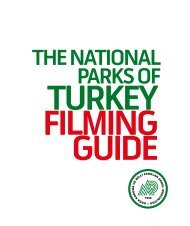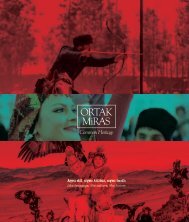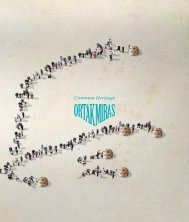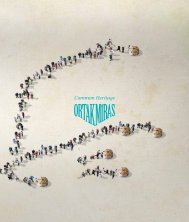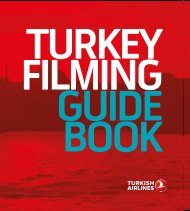Create successful ePaper yourself
Turn your PDF publications into a flip-book with our unique Google optimized e-Paper software.
Common Heritage<br />
344<br />
Ortak Miras<br />
Oyunun “çocuğu yaşama hazırlayan eğitim aracı; çocuğun<br />
zevk aldığı faaliyet; çocuğu aktif hale getiren etkinlik;<br />
çocuğun en önemli işi; çocuklar arası <strong>ortak</strong> anlaşma<br />
yolu; çocuğun doğal öğrenme ortamı; çocuğun özgürlüğü;<br />
çocuğun hoşlandığı için yaptığı faaliyet; çocuğun en<br />
etkin öğrenme süreci; çocuğun eğlencesi; çocuğun yoğun<br />
yaşantısı; çocuğun yaratma ortamı; çocuğun gerçek dünya<br />
ile hayal dünyası arasındaki köprü; çocuğu tanıma aracı;<br />
çocuğun kişiliğinin bir aynası; çocuğun hakkı” şeklindeki<br />
tanımları daha çok çocuk eğitimi ve psikolojisi alanlarına<br />
özgüdür. Buna karşılık kültür araştırmaları alanında<br />
da çocuk oyunları farklı boyutlardan değerlendirilmiştir.<br />
“Binlerce yıllık halk kültürü <strong>miras</strong>ı; çocuğa kimlik kazandıran<br />
etkinlik; çocuğun temel kültürlenme bağlamı;<br />
kültürel <strong>miras</strong> aktarım ortamı” gibi tanımlar bu türdendir<br />
(Özdemir 2006: 21- 41, 437- 456).<br />
Çocuk oyunlarının belirgin özellikleri olarak “isteğe bağlılık,<br />
gönüllülük, gerçek yaşamdan geçici olarak ayrılış,<br />
büyüleyicilik, kurallılık, taklit, süreç odaklılık, aktif katılım,<br />
esneklik, serbestlik, zaman ve süre açısından belirsizlik,<br />
kurgusallık, doğallık, eğlendiricilik vb.” gösterilmiştir.<br />
Çocuk oyunlarının işlevsel açıdan çözümlenirken “artık<br />
enerji, yaşama hazırlık, taklit-tekrar, içgüdü, boşalım, dinlenme,<br />
yeniden yaratma, kendini ifade etme, toplumsal<br />
buluş, kültürlere göre biçimlenme, canlandırma, rahatlama<br />
vb.” merkezli kuram ve yaklaşımlardan yararlanılmıştır.<br />
Diğer yandan yaş ve bağlam (tarihî, toplumsal, kültürel,<br />
eğitimsel, ekonomik, siyasal ve teknolojik şartlar vb.)<br />
çocuk oyunlarını biçimlendiren temel dinamikler olarak<br />
kabul edilebilir (Özdemir 2006: 21- 56).<br />
Çocuk oyunları “işlev (aklı, bedeni geliştiren-eğiten oyunlar;<br />
gönül eğlendiren, gönlü hoş eden oyunlar vb.), oyun<br />
hareketi (atlama, koşma, sıçrama oyunları vb.), oyun niteliği<br />
(zekaya dayanan oyunlar, eğlendirici oyunlar vb.),<br />
oyun aracı (araçlı- araçsız oyunlar, aşık, değnek, misket,<br />
yüzük oyunu vb.), oyuncular (kız- erkek çocuk oyunları<br />
vb.), oyun tekerlemesi (tekerlemeli- tekerlemesiz oyunlar<br />
vb.), oyun yeri (aşık hava- kapalı mekan çocuk oyunları<br />
vb.), yerleşim birimi (köy- şehir çocuk oyunları vb.), ezgi<br />
(ezgili- ezgisiz çocuk oyunları vb.), oyun zamanı (kış- yaz<br />
çocuk oyunları, gece- gündüz çocuk oyunları vb.), oyun<br />
çizimi/sahası (çizgili- çizgisiz çocuk oyunları gibi), oyuncu<br />
düzeni (daire-sıra- dağınık- karşılıklı düzende çocuk<br />
oyunları vb.)” şeklinde ifade edilebilecek ölçütlere göre<br />
kümelenerek değerlendirildiği belirlenmiştir. Buna karşılık<br />
çocuk oyunlarının temel oynanma biçimi bakımından<br />
kümelenerek yöresel ve tarihsel çeşitlemeleri temelinde<br />
kataloglanarak arşivlenmesinin işlevsel olacağı görülmüştür<br />
(Özdemir 2006: 86- 100).<br />
among children; the children’s natural learning environment; the<br />
freedom of the child; the activity the child has done for his / her<br />
liking; the child’s most effective learning process; the entertainment<br />
of the child; the intense experience of the child; the child’s creating<br />
environment; the bridge between the child’s real world and imaginary<br />
world; the way of knowing the child; a mirror of the child’s<br />
personality; children’s rights” are definitions that are peculiar to<br />
the fields of child education and psychology. On the other hand, in<br />
the field of cultural studies, children’s games have evaluated from<br />
different dimensions. There are definitions such as “the heritage<br />
of thousands of years of folk culture; activity that gives the child<br />
identity; the basic cultural context of the child; cultural heritage<br />
transmission environment “(Özdemir 2006: 21-41, 437-456).<br />
The distinctive features of children’s games are shown as “volition,<br />
voluntary, temporal separation from real life, fascination, prescriptivism,<br />
imitation, process orientation, active participation, flexibility,<br />
freedom, uncertainty in terms of time and duration, fiction,<br />
naturalness, amusement etc.” When children’s games are resolved<br />
from a functional point of view, they have benefited from theories<br />
and approaches based on “waste energy, preparation to life, imitation-repetition,<br />
instinct, emptiness, rest, recreation, self-expression,<br />
social invention, shaping according to cultures, animation,<br />
relaxation.” On the other hand, age and context (historical, social,<br />
cultural, educational, economic, political and technological conditions,<br />
etc.) can be regarded as fundamental dynamics shaping children’s<br />
game (Özdemir 2006: 21- 56).<br />
It is stated that children’s plays are evaluated according to the criteria<br />
that can be expressed as “function (plays educating intelligence<br />
and body; amusing plays, pleasing plays, etc.), game action (jumping,<br />
running, bouncing games, etc.), game quality (intelligent<br />
games, funny games etc.), game tool (games with or without tool,<br />
knuckle-bone games, marbles etc.), players (boy’s and girl’s game<br />
etc.), rhyme for game (game with or without rhyme, etc.), game<br />
room (games in open or closed spaces etc.), residential unit (village<br />
or city children’s games, etc.), tune (children’s games with or without<br />
echoes etc.), game time (winter or summer games, day or night<br />
games for children), player’s style. On the other hand, it has been<br />
seen that cataloging and archiving based on regional and historical<br />
variations will be functional in terms of the basic playing style of<br />
children’s games (Özdemir 2006: 86-100).<br />
Children’s games in Turkish world consist of structural elements<br />
such as “game name, player/s, game roles, game vehicle/toy, game<br />
place, play time and duration, determination of distribution and<br />
start sequence of game roles, rhymes/prizes, game rules, game movements,<br />
awards or punishment for the game”. Children remember<br />
the other structural elements of the game when they determine the<br />
name of the game. In Turkish world, children give names to their<br />
game according to its tool, movement, role, field etc. In traditional<br />
children’s games, every element of the environment can be used as











